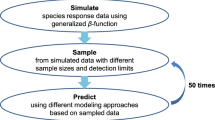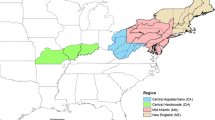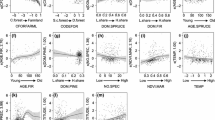Abstract
An expert on local flora usually is the best option for plant species selection in most ecological restoration projects; although species selection often needs to be dealt with swiftly as well as on a limited budget, and obtaining the opinion of a local expert may not always be an economically viable alternative. In such cases, species distribution models (SDM) may offer a faster and more cost effective alternative. We asked six experts to rank native tree species according to their suitability at 24 forest sites. The predictive performance of the suitability rankings was evaluated by assessing their ability to discriminate present from absent species in the observed tree assemblages at each evaluation site. We used the area under the receiver operating characteristic curve to calculate the probability that the estimated suitability for a species present at a particular evaluation site is greater than the estimate for an absent species (both picked at random). Suitability rankings were also obtained from the predictions of SDM and the same procedure was used to estimate the predictive performance of the set of models at each site. The experts offered concordant suitability rankings at almost every evaluation site. There were no significant differences in the predictive performance of the SDM and four of the experts, although the SDM performed slightly better than the other two experts. Our results point to the suitability of the proposed species distribution modeling approach to obtain fast and cost effective recommendations for species selection in forest restoration projects.



Similar content being viewed by others
References
Anderson RP, Lew D, Peterson AT (2003) Evaluating predictive models of species’ distributions: criteria for selecting optimal models. Ecol Model 162:211–232
Araújo MB, Peterson AT (2012) Uses and misuses of bioclimatic envelope modeling. Ecology 93:1527–1539
Booth TH, Jones PG (1998) Identifying climatically suitable areas for growing particular trees in Latin America. For Ecol Manage 108:167–173
Booth TH, Nix HA, Busby JR, Hutchinson MF (2014) Bioclim: the first species distribution modelling package, its early applications and relevance to most current MaxEnt studies. Divers Distrib 20:1–9
Bunce RGH, Barr CJ, Whittaker HA (1983) A stratification system for ecological sampling. In: Fuller RM (ed) Ecological mapping from ground, air and space. Institute of Terrestrial Ecology, Cambridge, pp 39–46
Busby JR (1991) BIOCLIM—a bioclimatic analysis and prediction system. In: Margules CR, Austin M (eds) Nature conservation: cost effective biological surveys and data analysis. CSIRO, Melbourne, pp 64–68
Clewell A, Rieger J, Munro J (2005) Guidelines for developing and managing ecological restoration projects. Society for Ecological Restoration, Tucson (USA)
Cuesta B, Benayas JMR, Gallardo A, Villar-Salvador P, González-Espinosa M (2012) Soil chemical properties in abandoned Mediterranean cropland after succession and oak reforestation. Acta Oecol 38:58–65
Elena Rosselló R (1997) Clasificación biogeoclimática de España peninsular y balear. Ministerio de Agricultura Pesca y Alimentación, Madrid (España)
Farr TG, Rosen PA, Caro E, Crippen R, Duren R, Hensley S, Kobrick M, Paller M, Rodriguez E, Roth L, Seal D, Shaffer S, Shimada J, Umland J, Werner M, Oskin M, Burbank D, Alsdorf D (2007) The shuttle radar topography mission. Rev Geophys 45(2):1–33
Felicísimo AM (2003) Uses of spatial predictive models in forested areas territorial planning. CIOT-IV international conference on spatial planning, pp 1–15
Fielding AH, Bell JF (1997) A review of methods for the assessment of prediction errors in conservation presence/absence models. Environ Conserv 24:38–49
Gandullo JM, Sánchez Palomares O (1994) Estaciones ecológicas de los pinares españoles. ICONA, Madrid (España)
García López JM, Allúe Camacho C (2004) Ensayo de un sistema fitoclimático de carácter autoecológico para especies arbóreas forestales en la Península Ibérica y su aplicación en labores de repoblación forestal. Actas IV Congreso Forestal Español pp 1–8
Gastón A, García-Viñas JI (2011) Modelling species distributions with penalised logistic regressions: a comparison with maximum entropy models. Ecol Model 222:2037–2041
Gastón A, García-Viñas JI (2013) Evaluating the predictive performance of stacked species distribution models applied to plant species selection in ecological restoration. Ecol Model 263:103–108
Guisan A, Thuiller W (2005) Predicting species distribution: offering more than simple habitat models. Ecol Lett 8:993–1009
Harrell FE (2001) Regression modeling strategies: with applications to linear models, logistic regression and survival analysis. Springer, New York
Harrell FE (2013) rms: Regression modeling strategies. R package version 3.6-3
Harrell FE, Califf RM, Pryor DB, Lee KL, Rosati RA (1982) Evaluating the yield of medical tests. JAMA-J Am Med Assoc 247:2543–2546
Legendre P (2005) Species associations: the Kendall coefficient of concordance revisited. J Agric Biol Environ Stat 10:226–245
McIver J, Starr L (2001) Restoration of degraded lands in the interior Columbia River basin: passive vs. active approaches. For Ecol Manage 153:15–28
Oksanen J, Minchin PR (2002) Continuum theory revisited: what shape are species responses along ecological gradients? Ecol Model 157:119–129
Oksanen J, Blanchet FG, Kindt R, Legendre P, Minchin PR, O’Hara RB, Simpson GL, Solymos P, Stevens MHH, Wagner H (2013) Vegan: community ecology R package version 2.0-8
Padilla FM, Ortega R, Sánchez J, Pugnaire FI (2009) Rethinking species selection for restoration of arid shrublands. Basic Appl Ecol 10:640–647
Pearce JL, Ferrier S (2000) Evaluating the predictive performance of habitat models developed using logistic regression. Ecol Model 133:225–245
Pearce JL, Cherry KMDS, Whish G (2001) Incorporating expert opinion and fine-scale vegetation mapping into statistical models of faunal distribution. J Appl Ecol 38:412–424
Peman Garcia J, Navarro Cerrillo RM, Serrada Hierro R (2008) Species selection guidelines in reforestation. Ruiz de la Torre’s contributions. Inv Agrar-Sist Rec F 15:87–102
R Core Team (2013) R: a language and environment for statistical computing. R Foundation for Statistical Computing, Vienna, Austria, http://www.R-project.org
Reineking B, Schröder B (2006) Constrain to perform: regularization of habitat models. Ecol Model 193:675–690
Ruiz de la Torre J (1990) Mapa forestal de España. Memoria general. ICONA, Madrid (España)
Ruiz de la Torre J, Gil P, García-Viñas JI, González-Adrados JR, Gil F (1990) Catálogo de especies vegetales a utilizar en plantaciones de carreteras. Ministerio de Obras Públicas y Urbanismo, Madrid (España)
Sánchez Palomares O, Sánchez Serrano F, Carretero MP (1999) Modelos y cartografía de estimaciones climáticas termopluviométricas para la España peninsular. Instituto Nacional de Investigaciones Agrarias Madrid, España
Seoane J, Bustamante J, Díaz-Delgado R (2005) Effect of expert opinion on the predictive ability of environmental models of bird distribution. Conserv Biol 19:512–522
SER (2004) The SER international primer on ecological restoration. Society for Ecological Restoration International, Tucson (USA)
Swets J (1988) Measuring the accuracy of diagnostic systems. Science 240:1285–1293
Thuiller W (2003) BIOMOD—optimizing predictions of species distributions and projecting potential future shifts under global change. Glob Chang Biol 9:1353–1362
Tibshirani R (1994) Regression shrinkage and selection via the Lasso. J R Stat Soc B 58:267–288
Van Liedekerke M, Jones A, Panagos P (2006) ESDBv2 Raster library, a set of rasters derived from the European Soil Database distribution v2.0. European Commission and the European Soil Bureau Network, CDROM, EUR 19945 EN
van Zonneveld M, Castañeda N, Scheldeman X, van Etten J, Van Damme P (2013) Application of consensus theory to formalize expert evaluations of plant species distribution models. Appl Veg Sci. doi:10.1111/avsc.12081
Webb DB, Wood PJ, Smith J (1980) A guide to species selection for tropical and sub-tropical plantations. Tropical forestry papers 15, University of Oxford, Oxford
Author information
Authors and Affiliations
Corresponding author
Rights and permissions
About this article
Cite this article
Gastón, A., García-Viñas, J.I., Bravo-Fernández, A.J. et al. Species distribution models applied to plant species selection in forest restoration: are model predictions comparable to expert opinion?. New Forests 45, 641–653 (2014). https://doi.org/10.1007/s11056-014-9427-7
Received:
Accepted:
Published:
Issue Date:
DOI: https://doi.org/10.1007/s11056-014-9427-7




